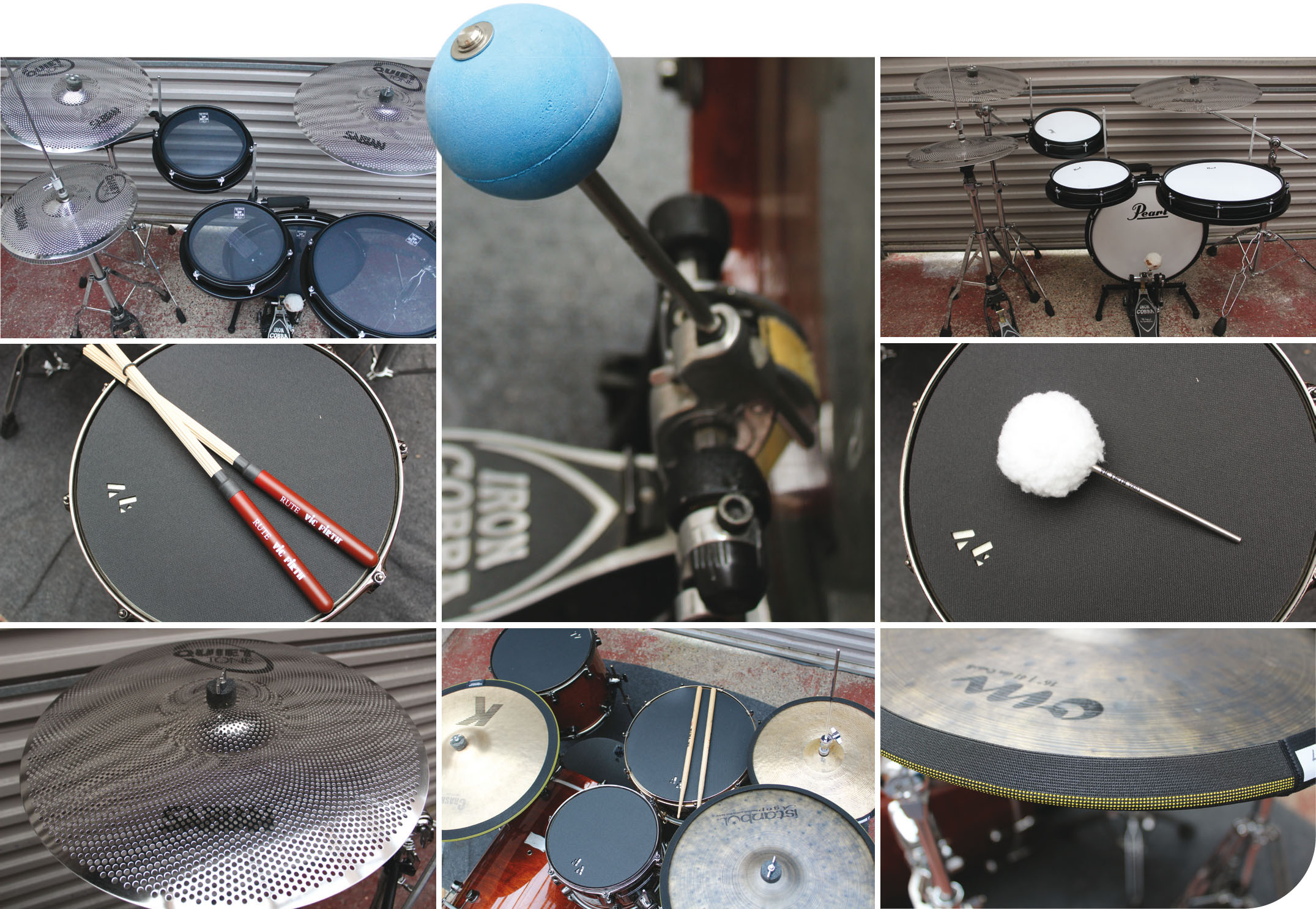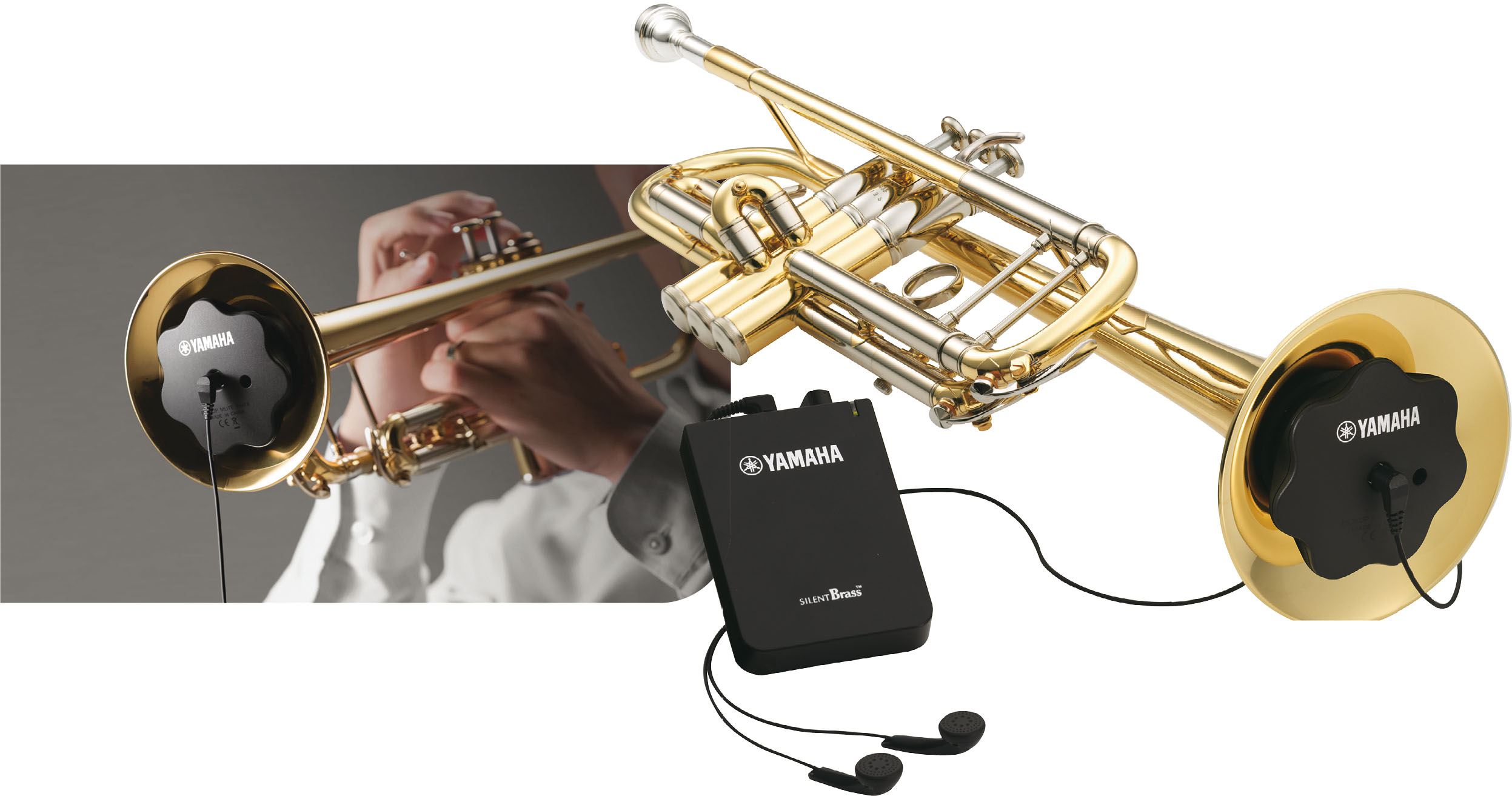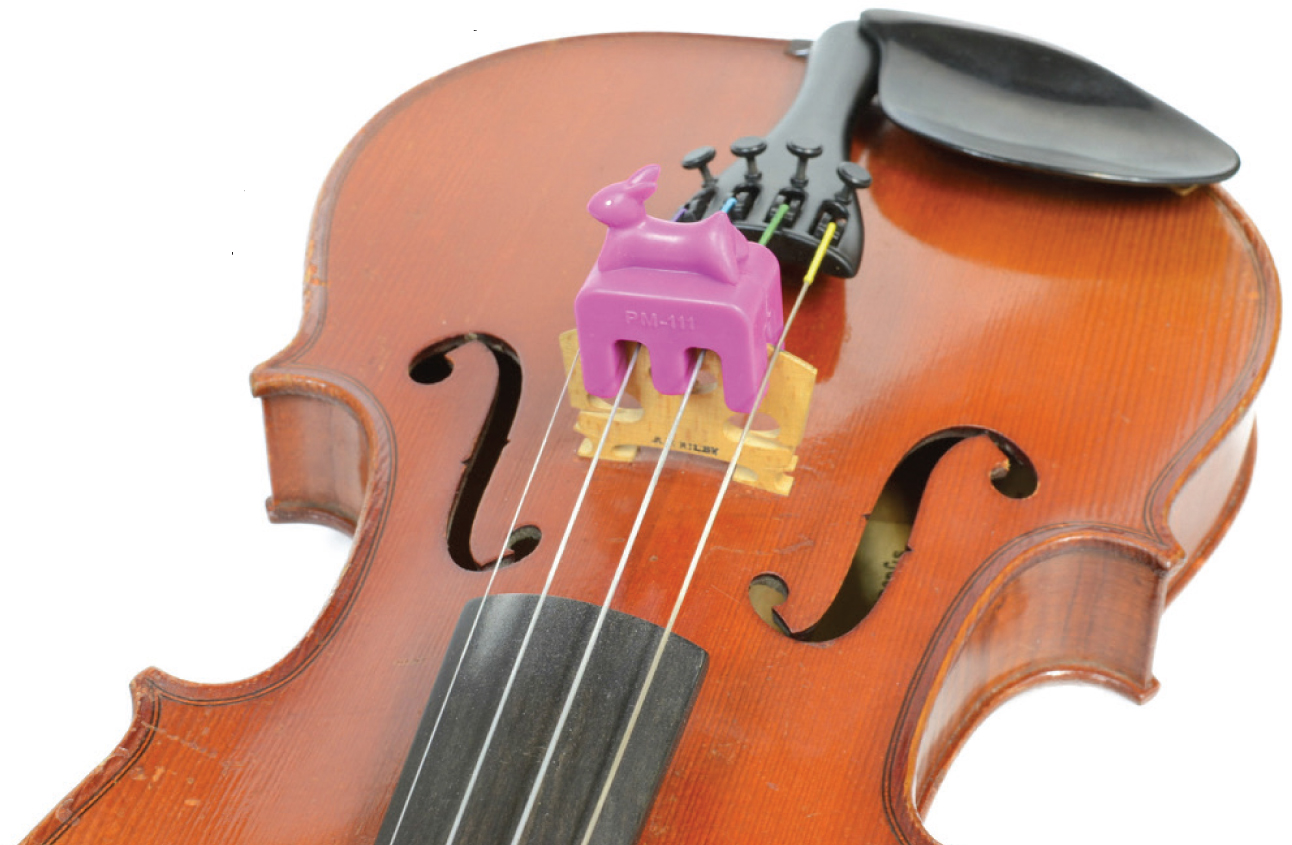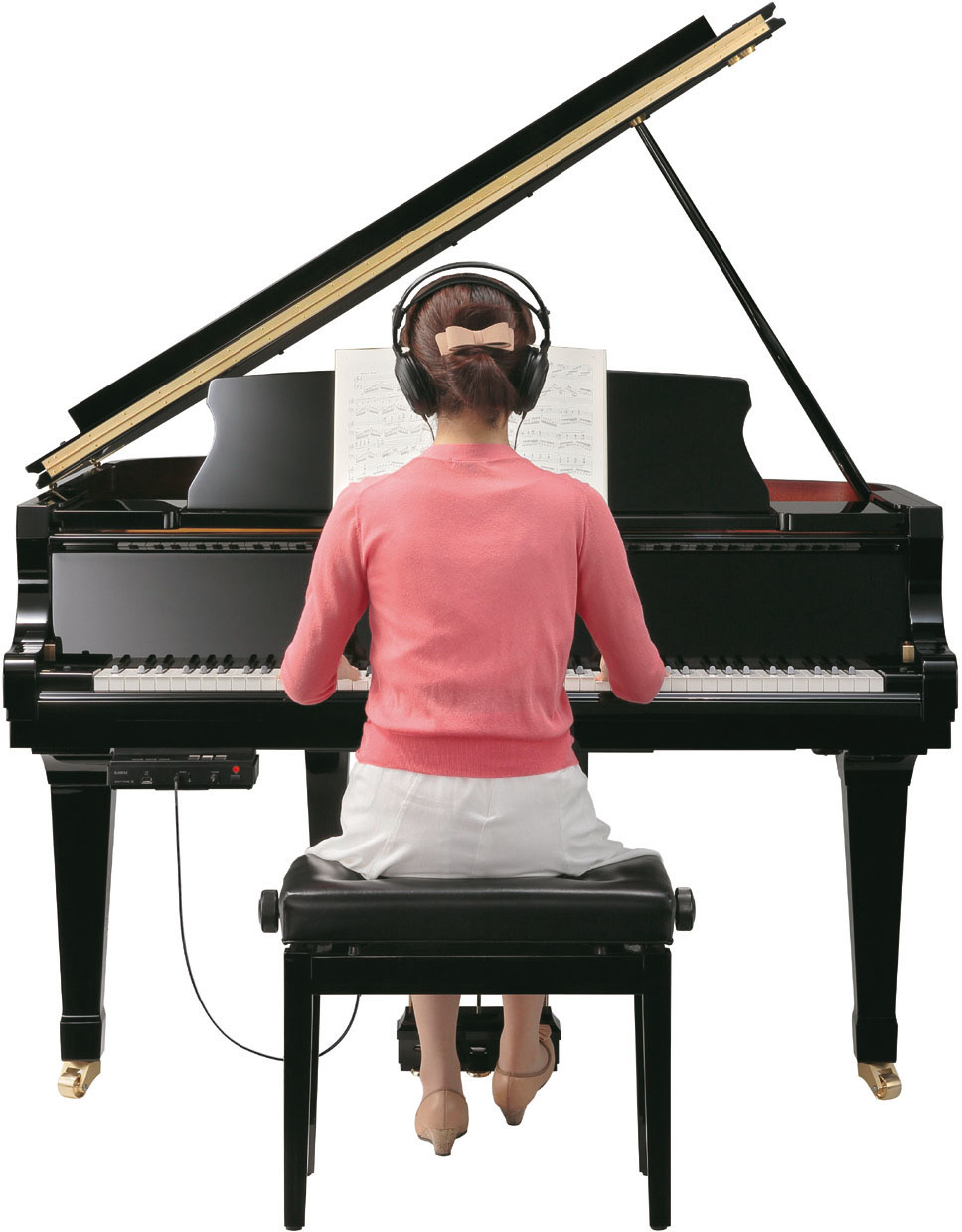
Drums
Lockdown brought violinists on balconies, Zoom choirs and live-streamed guitar gigs – but what about us drummers, for whom practising at home is fraught with practical issues? Obviously, in an ideal world, we'd all have expensive electronic kit and a sound-proof home studio. However, this is unrealistic for the majority of musicians and so tweaks to existing gear are far more viable.
Give it some stick
There are some low-fi methods that will reduce sound – such as using up-turned old drum heads on top of your drums – but there are more sophisticated solutions available, too. Vic Firth Rutes (RRP £29.99) are dowel-based sticks that are an essential part of any stick bag for the different sound they offer. If you're looking for a slightly softer timbre, useful for newer players with a heavier touch, they're perfect – but they don't quite offer enough of a reduction in volume for lockdown purposes.
The same could also be said of bass drum beater options. I looked at the Vic Firth fleece (RRP £37.79) and cajon bass drum beaters (RRP £23.99); both offered a slightly different sound which I really liked (think of the muffled sound associated with vintage jazz) but neither made a significant difference to the overall volume.
‘Muffliato!’
Vic Firth Drum Mutes (available in packs to cover the whole kit; RRP £89.99) are not unique but the package offered provides as good a result as I've seen from a pad set up. The pack (available in both rock and fusion sizes) provides rubber pads to sit on top of both the drums and cymbals, which mute the sound effectively. They are incredibly easy to install (and remove) and they provide excellent dampening on the drums. I found that the cymbals were still a little louder than I would have liked, particularly with open hi hats. I found that the stick response was significantly different to a drum head (though much better than most electronic kits) which may cause technique issues with newer players. However, a very simple and practical solution.

Clockwise: Pearl Muffle Heads; Vic Firth Cajon Bass Drum Beater; Pearl Rhythm Traveller; Vic Firth Fleece Bass Drum Beater; Cymbomutes; Vic Firth Drum Mutes; Sabian Quiet Tone Cymbals and Vic Firth Rute
Pearl muffle heads comprise a mesh drum head that is used in place of conventional drum heads. While not as simple to fi t and remove as the Vic Firth Drum Mutes, the feel is much closer to that of a normal drum head and the ability to change the tension of different heads is a real bonus. The volume is near silent and, although they work out a little pricier than pads (starting at around £9 each), I would argue they are a much better purchase.
Knicker elastic
My first drum teacher advised using what he described as a ring of ‘granny's knicker elastic’ to dampen the sound of cymbals. Cymbomutes takes this idea further: a ring of elastic with an embedded ring of silicon is stretched around your existing cymbals. I was genuinely impressed with the results – this was the quietest I've heard my cymbals. Playing with the tip of the stick on the bow of the ride cymbal produces a high-pitched ‘tick’ sound, but the crash and hats are near silent. They were initially rather fiddly to fit but, once on, remained solid and provided all the response I would usually get from my cymbals. They're also a relatively cheap solution. The pack I used, which covered my 14” hi hats, 16” crash and 20” ride, costs £30.57.
Alternative kit
If you're looking to add extra equipment rather than adapt existing gear there are further options. I tried the Pearl Compact Traveller Kit, a fantastic little kit capable of a quieter overall sound. Coupled with a minute footprint it's ideal for small practice setups and I could even see it working well for an acoustic gig. However, the overall volume was still reasonably loud. The Compact Traveller I played is available from around £475 (without stands) though the kit is available with just kick and snare from £215, which makes it a tempting option for those looking to add an extra practice/small gig kit to their collection.
The Sabian Quiet Tone cymbals were revelatory. Cymbals such as these (with a great deal of holes drilled through them to reduce volume) have been on the market for a number of years but this was the first time I'd had the opportunity to try them out and I was amazed by the drop in volume and their playability. I only heard a light high-pitched sustain, even when playing heavily, and they were incredibly satisfying to use. The price (the set I played consisting of 14” hi hats, 16” crash and 20” ride is available from around £256) puts them out of reach of many musicians looking for a short-term solution, but they make a great addition to any full-time practice kit.
As with most things, the best options are often the most expensive. The setup which worked best for me was the Pearl Compact Traveller with the addition of the Muffle Heads and Sabian Quiet Tone cymbals as the combination of a significant reduction in volume without a difference in feel was a real bonus. However, as a short-term solution, the Vic Firth Drum Mutes are excellent.
GUY SWINTON

Silent night: Yamaha's Silent Brass System
Brass
Practice mutes are available for all brass instruments, and it is a rich and diverse field. Prices range from £15 for a simple cornet practice mute to around £500 for a Yamaha tuba Silent Brass System (pictured). A good starting point is Johnpacker.co.uk, where you can conduct a search with filters for instrument, mute type, brand and price. If you're looking for a mute as a gift, you want a model that will remain in tune over the whole register and that doesn't need any extra puff (the ‘resistance’).
Brass mutes are very effective – they reduce the volume drastically, and you won't disturb anyone in the next room. But they are mainly intended for note bashing and keeping your chops in shape. For work on tone you really need to hear your instrument out loud in all its glory.
Yamaha's ‘Silent Brass’ systems are quite something. They comprise a ‘pickup mute’, stereo headphones and a digital processor module. The big advantage of the Silent Brass system is in the module element, which is a small battery-powered device the size of a phone (batteries not included by the way, so if you're ordering while isolating you need to plan for that). It connects the mute to headphones, and allows you to add reverb. You can record yourself, and play along with external audio through the headphones using the ‘Aux in’ jack. If you just want a practice mute, it is possible to buy that element of the Silent Brass system separately, but it is arguably not worth paying hundreds of pounds for – there are cheaper standalone practice mutes that will do the same job.
One thing to look for when buying a brass practice mute is its size and where it sits in the instrument. A model that fits in the bell entirely will be much easier to transport, as you don't need more room in your case.
Strings and guitar
It is possible to buy practice mutes for all orchestral stringed instruments – what is more, they aren't all that expensive. (Between £5 to £30) Well-known and reliable brands include Ultra and Artino. Practice mutes for violins and violas are reasonably effective, and many players report that with a heavy rubber or metal model they can't be heard through walls when using them. Cello practice mutes are anecdotally reported to cut the sound down by around half, which may or may not keep everyone happy, depending on the thickness of your walls. The ‘Ultra’ heavy rubber double bass mute claims to cut a standard 62–86.4 db unmuted volume range to a 50.8–76.4 db range and costs in the range of £9 to £16, depending on the vendor. For cellos and double basses, a rubber tip on the endpin will help to stop vibrations passing through the floor to rooms below, and a pillow under the tailpiece of a bass will also help to dampen its massive top plate.
If you want to buy a present for a beginner, you could take a look at Artino's range of children's practice mutes for violin and small viola (pictured). They cost £7.20 for a plain model or £8.40 for an animal model (including ‘Blue Bird’, and ‘Red Rabbit’) from thestringzone.co.uk.
As with brass mutes, stringed instrument mutes are primarily for note bashing. They cut out overtones in your sound, which successfully reduces the volume but also means that you can't work seriously on sound quality.
For acoustic guitars, the cheapest and most widely used method for muting the sound is simply to stick a pad of material between the wood and the strings up by the bridge. As well as being cheap, it's fun to play with the varying sonorities that different materials/objects will give you. There are also specialist practice mutes available, including a D’Addario model that fills the sound hole and various rubber models that sit under the strings.

String things: Artino's mutes are ideal for young beginners
Vocal
Much to the dismay of choir directors through the ages, there are no mutes for singers. Unless you have the budget for a studio-style installation, the closest thing to a mute is a portable sound booth of some sort. These are pricey, usually several hundred pounds, and range in size from a changing-room affair with foam or fabric walls to what is essentially a box on a stand into which you can put your head. Many of these products are aimed at getting a clean audio environment for singers wanting to record themselves, and not at reducing the volume of a trained voice, but there are some that market themselves on decibel reduction. Vocalboothtogo.co.uk does just this, and it has many different products to choose from.
If you decide to practice in your car, be sure to open the windows as often as possible. There's a genuine possibility of damaging your ears if you let loose in a reflective small space such as a car for long periods every day.
If your most realistic option is the DIY route, thick rugs, soundproofing curtains, and tacked-up foam, vinyl or acoustic insulation will all help. It might be best to go for a booth-style set up, so you aren't ruining your entire décor.
THOMAS LYDON
Woodwind
Woodwind instruments are among the hardest to keep quiet. This is due to physics. Rather than the sound coming from a single opening – the bell of a brass instrument, for example – on woodwind instruments it emanates from all the uncovered finger holes as well as the open end. Shove a sock up an oboe and you won't notice much difference, apart from a muffling effect at the bottom end.
With woodwind, then, you have to think laterally to minimise noise. First, dampen the acoustics of your practice space by pinning up duvets, blankets, egg boxes or foam blocks. If possible, practise in a room far removed from sensitive ears.
Avoid playing quietly, which doesn't have much to recommend it as a noise-reducing technique. You are likely to create bad habits if you permanently deny yourself the louder end of the range, and people who are inclined to get annoyed by musical instruments won't appreciate the effort you are making anyway.
Press mute
The saxophone has the most options for muting, perhaps because it is the woodwind family's loudest member. The MMD Saxmute (for soprano, alto, tenor or baritone – it can also be used on the clarinet) costs approximately £35. It works by inserting foam noise reducers at different points inside the saxophone. This creates a somewhat uneven reduction of sound, and there are other penalties in terms of a stuffy playing experience, which could affect a developing player's technique. But it does at least have some muting effect, unlike the various cheap sax mutes available on Amazon, which are unlikely to work at all. In the same price range, you could also try the JazzLab Silencer (soprano, alto, tenor, baritone or clarinet), which fits onto the base of the mouthpiece for some mouthpiece-only silent practice – not much good for playing a tune, but potentially worthwhile as embouchure training.
Another category of sax mute is the sound-limiting case that closes around the instrument with holes for the mouthpiece and your hands. These devices look rather absurd but are a genuine attempt to mute the sound of the sax based on its particular sonic properties. Two are available: the Saxmute ONE and the E-sax Whisper (pictured). The Saxmute ONE costs about £300; it is for alto sax and fits to a Hercules stand to bear the weight. The E-sax Whisper is £460 for alto and £560 for tenor. It doesn't fit a stand but can run a cable in and out – so you can attach a mic and listen to your muted sax via headphones as you play! These products really work – as a sax.co.uk demo video on YouTube shows – but they can be cumbersome and the cost will rule them out for many. That said, according to Jamie Straker, director of sax.co.uk, ‘Over the lockdown period, the Saxmute ONE became so popular that we had to disable ordering online in order to catch up with the demand.’ But fear not: Straker has placed a large order and expects the product to be available again soon.
Some exceptions
No muting products for oboe and bassoon are currently available. Check with friends and colleagues for any homemade tips, but don't hold your breath. The clarinet can use some of the sax products already mentioned, but no case-style mute for it been developed so far; perhaps one is in the works.
The flute, to the best of my knowledge, is un-mutable. Thinking laterally again, consider the alto fl ute if you can access one, as this is altogether a more mellow instrument – or work on your recorder doubling (the larger recorders are softer).
On the subject of alternative instruments, there's always the Akai EWI (electronic wind instrument) or equivalents like Roland's Aerophone. These digital instruments are exciting to play, and while they won't help your technique on your main instrument, they could help you explore new areas of your musicality – and they can be played silently with headphones.
CHRIS WALTERS
Pianos
It is important to remember that we can do so much without going near a keyboard. Internalising your music and learning to practice at a desk is an invaluable technique, one which Walter Gieseking apparently religiously adhered to, refusing to even go near his piano until he had internally memorised every note of a new piece. Begin with simple phrases and move upwards, singing and conducting your repertoire for added involvement and focus.
Dummy keyboards
But how can we keep our fingers in shape without making lots of noise? Are scales, arpeggios, and Hanon exercises simply out of the question if you have intolerant housemates or neighbours? The answer is to buy a dummy practice keyboard. These have been around for well over a century, but today they often include adjustable devices (key touch weights) that alter the heaviness of the action instantly, as well as magnets that are adjustable as necessary to change the depression of each key (Pinkham Pianos stock specialist dummy keyboards).

Digital pianos
Of course, many upright pianos come with a mute pedal, in which case you will already have your own pre-installed version of the ‘dummy keyboard’. But this can only take you so far. For the long haul you will need to get an instrument that can take headphones. Depending on your budget, you can opt for an inexpensive keyboard, or an instrument from Roland, Casio, Kawai or Yamaha to mention but a few of the more popular options on the market. Casio has recently produced a wonderful range of Celviano instruments. Kawai has some outstanding hybrid pianos, combining the best of acoustic action with lots of exciting extras.
There is a huge range to choose from, but do if you are interested in uprights, do check out the Kawai ATX3 Anytime silent piano. Of course Yamaha Hybrid Silent pianos, the Yamaha Avant Grand, and its various formats have been around for some time, and at the very top of the range Yamaha has been pioneering in emulating the very best sound from Bösendorfer and the Yamaha CFX top concert instruments. Steinway and Bösendorfer have also been proactive in embracing silent devices that are installed as alternative features to their instruments. It is worth looking at silent devices that can be retrofitted – check out adsilent (www.adsilent.eu) as well as the PianoDisc QuietTime products. (NB Yamaha is currently offering an extended 5 year guarantee on its Silent Series pianos when customers register their new instrument online.)
A word in your ear
Arguably a good, comfortable set of headphones is just as important as a sympathetic instrument. Depending on your budget, you can opt for a top-of-the-range affair from the likes of Bose (which could set you back £900) or work your way down to sets that may be less than £20 second hand, but which fail to block out extraneous noise. Over ear phones tend to be more effective for disturbance-free practising, and it is worth investing in a good pair from the likes of Sony (MDR-7506), Philips (Fidelio M2BT), Yamaha (HPH-50B), Sennheiser (HD598), Beyerdynamic (DT880), or Tascam (TH-02) to name just some. Personally, I get uncomfortable with headphones on after a few hours of practice, so I invested in a pair of bone-conducted headphones, which provide sound through vibrations through the skull – leaving ears free and more comfortable (check out Aftershokz Trekz wireless Bluetooth bone conduction headphones, retailing about £100, which come with a complimentary pair of ear plugs to block out environmental noise).
A design classic
Finally, it is worth remembering the quietest keyboard instrument of them all, the clavichord. Bach recommended that all keyboard players master touch and control on this modest, but remarkably expressive and tender instrument, and in recent years Boris Berman, the head of keyboard at Yale, has encouraged virtuoso piano students towards more mindful touch control and digital awareness by introducing them to the delights of this much neglected, but extremely sensitive instrument. András Schiff once commented that ‘the clavichord is my best teacher because it makes me listen very carefully. The sound is so delicate and the touch so sensitive, it shows all my shortcomings immediately. I would make clavichord practice compulsory for all pianists’.
MURRAY MCLACHLAN
Final thoughts
If your neighbours can hear you, the polite thing to do is to send a note around saying that your instrument and/or voice is your job and that you will practice only at a particular time each day, inviting feedback as to what time would be best.
Most local authorities in the UK allow instruments to be practised at reasonable hours if you own your home, and many tenancy or leasehold agreements rely similarly on what is ‘reasonable’. Where disputes have got as far as court, judges often find in favour of musicians. Inflicting a bit of practice on your neighbour isn't the worst thing you can do, especially if you are willing to be flexible about when you do it.
Instead of practising quietly, try alternating normal playing with silent practice – studying a score or reflecting on interpretation. For earlier-stage learners this might involve a spot of theory work or some musical research set by a teacher.








